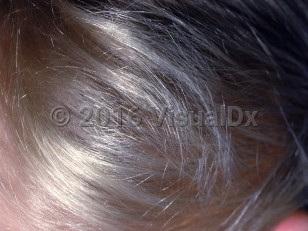Björnstad syndrome is a rare inherited disorder that causes hair and auditory abnormalities. While both autosomal dominant and autosomal recessive inheritance patterns have been reported in the literature, most cases are autosomal recessive. Mutations in the BCS1L gene, which is involved in mitochondrial function, are considered to be the cause of this syndrome.
Symptoms commonly begin in early childhood or may be present at birth. Sensorineural hearing loss, which is commonly bilateral, is accompanied by pili torti (flattened hair shafts and twists within each shaft). Pili torti affects scalp hair and results in hair that is brittle, fragile, and breaks easily. Hair may be shiny with what has been described as a "spangled appearance," or if the majority of hairs have been broken off, sparse scalp hair is seen. The degree of hair involvement was initially observed by Björnstad to be correlated with degree of hearing loss, and this has subsequently has been confirmed by other investigators.
Bjornstad syndrome in Adult
Alerts and Notices
Important News & Links
Synopsis

Codes
ICD10CM:
Q84.1 – Congenital morphological disturbances of hair, not elsewhere classified
SNOMEDCT:
67817003 – Pili torti-deafness syndrome
Q84.1 – Congenital morphological disturbances of hair, not elsewhere classified
SNOMEDCT:
67817003 – Pili torti-deafness syndrome
Look For
Subscription Required
Diagnostic Pearls
Subscription Required
Differential Diagnosis & Pitfalls

To perform a comparison, select diagnoses from the classic differential
Subscription Required
Best Tests
Subscription Required
Management Pearls
Subscription Required
Therapy
Subscription Required
References
Subscription Required
Last Reviewed:03/20/2018
Last Updated:01/11/2022
Last Updated:01/11/2022

